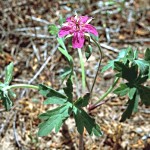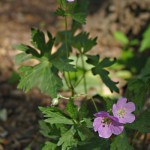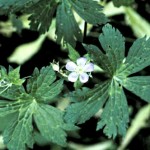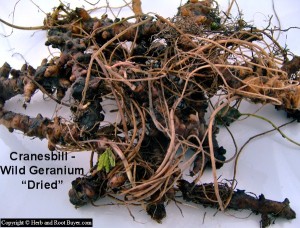Cranesbill-Wild Geranium – Geranium maculatum
|
Current Demand = Normal |
Parts Used: Root |
 |
 |
 |
 |
Family: Geraniaceae
Common Names: Bigroot Geranium Synonyms—Cranesbill, Crow Foot, Alum Root, spotted crane-s bill, wild crane’s bill, spotted geranium, old-maid’s-nightcap, shameface, alum-bloom, chocolate-flower, crowfoot…
Description:
This sticky, aromatic woodland perennial has hairy, toothed leaves that turn red-gold in the autumn, red to purple flowers and explosive seed dispersal. It is native to Eastern North America. It forms large clumps 12-14 inches tall covered with delicate rosy-lavender to soft pink flowers and bloom from spring to mid-summer. The seed pod explodes in mid-summer sending seeds in various directions leaving the open seed pod looking like a little brown flower with it’s petals turned back. It prefers woodland gardens, sunny edges, dappled shade, ground cover and bog gardens.
Part used: The root, collected just before the flowering period.
Harvest the roots as the plant comes to flower since it is then at its most active medicinally.
The roots should be washed in cold water and foreign material (rocks, dirt and other roots) must be removed. Never soak roots in an attempt to clean them. Separate the stem from the root where the two meet at ground level. Unless the buyer is purchasing fresh dug roots (which they often do) the clean roots need to be dried. Roots can be dried in the sun although if possible dry indoors in a well ventilated barn loft or attic to protect from the elements. If natural heat is not available, heat may need to be added and a fan added for continuous airflow. An old window screen or a wire mesh on a 2×4 frame works well for drying. Also, it is a good idea to turn the roots daily as the root may hold an abundance of moisture and molds easily, the turning will help prevent molding.
The key to drying herbs, roots or bark is an even combination of heat and airflow. Never dry in an oven or a microwave.
Once the root is completely dry (the stem will snap and not bend) in 3-7 days depending on the size of the root and the drying conditions, place in a cardboard box or paper bag for storage in a dry area until you are ready to sell or use. Do not place the root in plastic or it will mold.
Planting/Cultivation
Best grown in average, medium wet, well drained soil in the full sun to part shade. Deadheading is tedious and probably unnecessary since the plant usually does not rebloom. Seed – sow spring in a cold frame. When they are large enough to handle, prick the seedlings out into individual pots and plant them out in the summer. Larger clumps can be replanted direct into their permanent positions, though it is best to pot up smaller clumps and grow them on in a cold frame until they are rooting well. Plant them out in the spring.
Harvesting/Drying
Parts Used: roots
After harvest, remove all foreign matter (rocks, weeds and other roots) and spread in a thin layer immediately. When possible dry indoors in a well ventilated barn loft or attic to protect from the elements. If natural heat is not available you may need to add heat and a fan for continuous airflow. Whether you dry indoors or outdoors you will need to turn or stir the roots daily.
The key to drying any root, herb or bark is an even combination of heat and airflow. Never dry in an oven or microwave. They can be completely dry (largest stem will snap not bend) in 3-7 days depending on the drying conditions. Once it is dried place the roots carefully into a cardboard box or paper bag for storage in a dry area until you are ready to sell or use. Never store the tubers/roots in plastic or it can mold.
Attributes (Images)
I, TomR [CC BY 2.5], via Wikimedia Commons
By Stolz Gary M, U.S. Fish and Wildlife Service [Public domain], via Wikimedia Commons
By Photo (c)2010 Derek Ramsey (Ram-Man) (Own work (Own Picture)) [GFDL 1.2], via Wikimedia Commons
 Root Buyer
Root Buyer